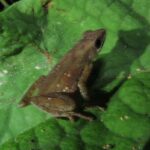- Introduction: A Frog of Quiet Charm and Secret Lives
- Taxonomy and Classification: Placing Ischnocnema feioi on the Tree of Life
- Natural Habitat: Within the Heart of Brazil’s Atlantic Rainforest
- Physical Characteristics: Small, Subtle, and Superbly Adapted
- Behavior and Life Cycle: Defying Amphibian Expectations
- Ecological Role: Guardians Within the Leaf-Litter Ecosystem
- Threats and Conservation Status: Safeguarding a Fragile Future
- Cultural and Scientific Significance: Bridging Nature and Humanity
- Conclusion: Embracing the Quiet Wonders of Nature
Introduction: A Frog of Quiet Charm and Secret Lives#
Hidden beneath the lush foliage of the Brazilian Atlantic Forest dwells a small, elusive amphibian whose very existence whispers quietly among moss-covered rocks and fallen leaves. Meet Ischnocnema feioi, a captivating frog species with a humble demeanor yet extraordinary ecological significance. Unlike some of its louder amphibian kin who trumpet through the canopy, this species embraces subtlety and secrecy. Known colloquially as Feio’s Robber Frog, Ischnocnema feioi bears a gentle charm and fascinating evolutionary adaptations that spark curiosity among naturalists and conservationists alike.
This frog, scientifically classified within the family Brachycephalidae and recognized for its remarkable reproductive strategies, leans away from the conventional tadpole stage. Instead, it accomplishes the remarkable feat of direct development, bypassing tadpolehood altogether. This unique trait, coupled with its habitat specificity, makes Ischnocnema feioi not only intriguing to amphibian enthusiasts but crucially important to understanding biodiversity within Brazil’s threatened ecosystems.
Taxonomy and Classification: Placing Ischnocnema feioi on the Tree of Life#
The scientific community formally recognizes this fascinating amphibian as Ischnocnema feioi, classified within the animal kingdom (Animalia), phylum Chordata, and class Amphibia. This species aligns neatly within the family Brachycephalidae—a diverse group of amphibians adapted to rainforest conditions.
The genus Ischnocnema encompasses various small to medium-sized frogs noted for their distinct reproductive methods. Within this genus, I. feioi was formally described and named relatively recently, in honor of the esteemed Brazilian herpetologist Renato Feio, whose work illuminated the amphibian diversity within the Atlantic Forest region. Closely related species like Ischnocnema henselii share similar direct-developing reproductive strategies and parallel ecological niches, suggesting intriguing evolutionary paths shaped by shared habitats.
Natural Habitat: Within the Heart of Brazil’s Atlantic Rainforest#
Ischnocnema feioi resides exclusively within the Brazilian Atlantic Forest biome, a globally recognized biodiversity hotspot stretching along Brazil’s eastern coastline. This region is marked by dense, verdant forests, abundant precipitation, and a wealth of microhabitats that foster unparalleled biodiversity.
An Existence Among Leaf-Litter Layers#
The preferred ecological niche of Feio’s Robber Frog can be found amongst the leaf-litter layers blanketing the forest floor. Beneath a canopy vibrant with bromeliads, orchids, and ferns, hidden in a heavenly carpet of decomposing foliage, these frogs thrive. Moisture, temperature consistency, and ample shelter make this microhabitat ideal for their survival, as well as supporting the direct development of their eggs.
The extensive leaf-litter forms a miniature world teeming with arthropods, ants, spiders, and other small prey that sustain this inconspicuous predator. The protective leafy embrace also shields this shy creature from predatory birds and mammals, providing camouflage that renders them almost invisible to casual observers.
Physical Characteristics: Small, Subtle, and Superbly Adapted#
Possessing a compact, delicate physique, Ischnocnema feioi typically achieves modest lengths, rarely exceeding 25mm (approximately one inch). Their diminutive stature allows seamless navigation and quick movements within the densely layered leaf-litter, deftly exploiting spaces inaccessible to larger amphibians.
Displaying shades of brown, tan, or rust-red, the coloration of Feio’s Robber Frog mirrors its surroundings spectacularly. Subtle markings and occasional spotting further enhance their cryptic disguise, allowing these frogs to effortlessly evade detection by both predators and human observers alike. Their skin exhibits fine granulation patterns, assisting in blending seamlessly into their organic habitat.
Adapted ideally to terrestrial life, their limbs are relatively short but robust, perfect for precise leaps and quick maneuvering within tight spaces. Their fingers and toes lack prominent webbing, instead designed for life spent predominantly on solid ground rather than aquatic terrains. Such morphological features portray a species profoundly specialized for its woodland habitat.
Behavior and Life Cycle: Defying Amphibian Expectations#
The life of Ischnocnema feioi differs profoundly from traditional frog narratives. Most frogs’ lifecycles famously involve aqueous tadpole stages, yet Feio’s Robber Frog boldly deviates. Instead, these amphibians showcase complete terrestrial development—a phenomenon known scientifically as direct development—where embryos develop into fully formed miniature adults within eggs, bypassing the vulnerable aquatic tadpole phase entirely.
A Chorus of Silence: Communication Without Noise#
Unlike the melodic, boisterous calls echoing from treetops or ponds from many frog species, Feio’s Robber Frog maintains subtlety even in communication, emitting softer calls primarily noticeable only during breeding periods and twilight hours. Males produce occasional quiet chirping notes, inaudible from a distance, well-suited to their concealed habitats. Such quiet communication facilitates mate selection while minimizing attention from predators.
Diet and Predation: Living on Leaf-Litter’s Approachable Bounty#
Feeding predominantly on small arthropods like ants, mites, beetles, and spiders, the frogs embody effective predation strategies within their modest territory. Efficient ambush hunters, they rely heavily on stealth, camouflage, and quickness. Their primary defense remains vigilant immobility, blending seamlessly into surroundings rather than risking overt confrontation.
Ecological Role: Guardians Within the Leaf-Litter Ecosystem#
Despite their small size and introverted demeanor, Ischnocnema feioi you play a substantial and irreplaceable ecological role. As voracious insectivores, they help control insect populations, effectively regulating forest-floor biodiversity. Simultaneously, their position within the food web means their health and abundance often serve as indicators of broader ecosystem well-being.
Moreover, the leaf-litter layer itself forms a critical ecological foundation, harboring insects that assist in nutrient recycling. The very presence and survival of these frogs signal the overall health and productivity of this delicate habitat. Their conservation thus signifies broader ecological integrity.
Threats and Conservation Status: Safeguarding a Fragile Future#
Like many amphibians confined to specific habitat niches, Ischnocnema feioi faces increasingly profound threats. Habitat destruction and fragmentation caused by deforestation, agriculture expansion, urban development, and climate-change-induced shifts present serious challenges demanding immediate conservation attention.
Presently, insufficient data prevents comprehensive assessment by organizations like the International Union for Conservation of Nature (IUCN), yet experts strongly advocate active habitat preservation tactics designed to protect the broader Atlantic Forest ecosystems. Local conservation initiatives—focused on habitat restoration, community education, scientific study, and ecological awareness—become crucial to conserving this singular frog and its irreplaceable habitat.
Cultural and Scientific Significance: Bridging Nature and Humanity#
Culturally and scientifically, Feio’s Robber Frog symbolizes the fragility and uniqueness of Brazil’s natural heritage. Its scientific discovery contributes insights into amphibian evolution, reproductive strategies, and forest ecology. Additionally, naming the species to honor eminent herpetologist Renato Feio underscores human passion, drive, and commitment in documenting and conserving biodiversity.
Such species transforms from mere biological specimens into ambassadors connecting humankind with nature. It serves as evidence, evidence that even the smallest creatures merit significant conservation effort, each contributing profoundly and uniquely to the health of our planet’s ecosystems.
Conclusion: Embracing the Quiet Wonders of Nature#
In contemplating the life of Ischnocnema feioi, we find invaluable lessons in biodiversity, ecological interconnectedness, and wildlife conservation. Its unassuming presence, rich ecological symbolism, and unique evolutionary pathway remind us of life’s hidden treasures awaiting discovery beneath our feet. Let this quiet yet resilient creature inspire deeper appreciation, curiosity, and determined action toward protecting fragile ecosystems. Immerse yourself further into the natural wonders around you, advocate for amphibian conservation efforts, and spread awareness about the irreplaceable significance of species like Feio’s Robber Frog. In safeguarding them, we ultimately safeguard ourselves, protecting the delicate tapestry of life sustaining our shared planet.







